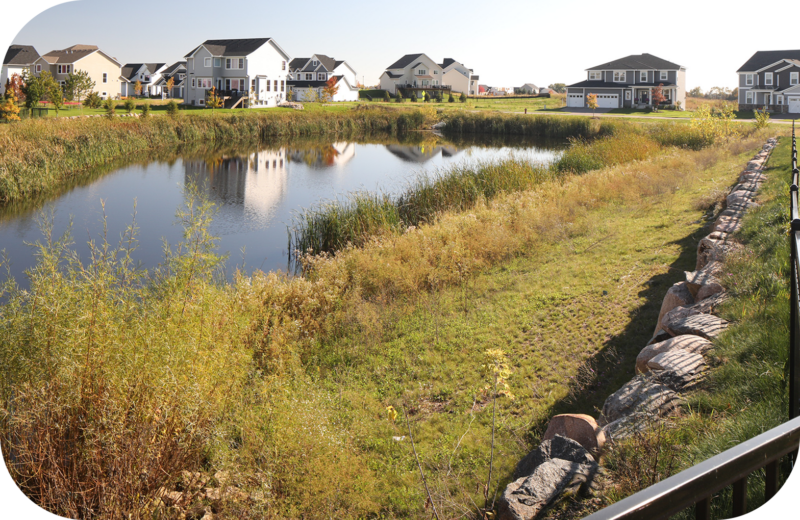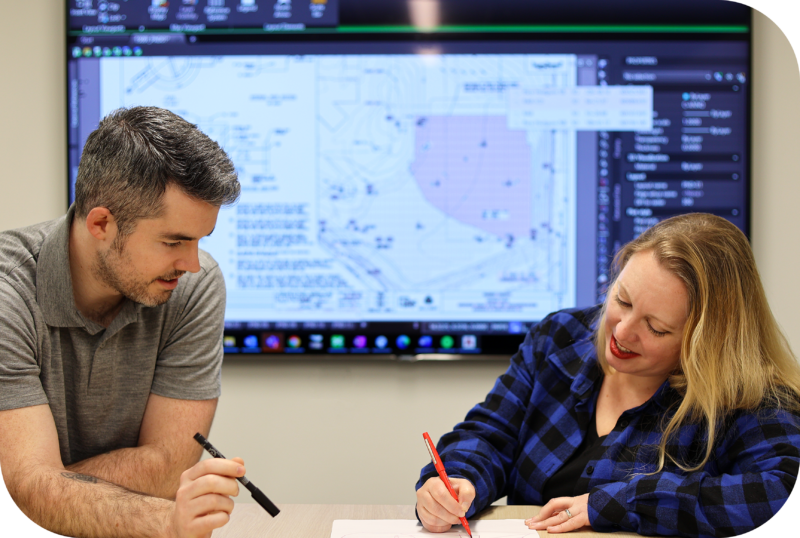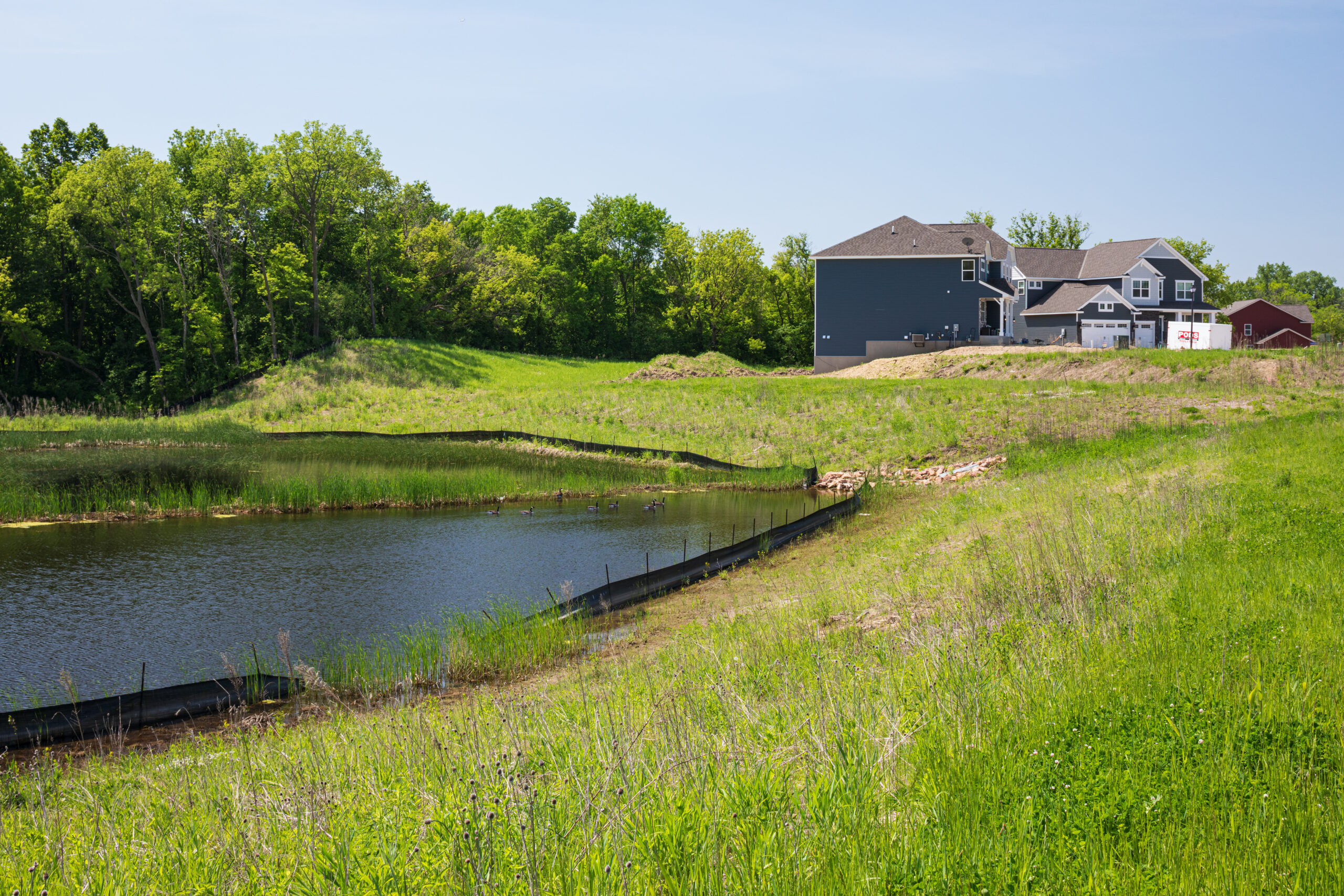Hydraulic engineering designs work best when the public has no idea there’s a drainage system in place.
When stormwater management systems are designed correctly, buildings remain dry and roads remain safe for traveling no matter the weather. To maintain these optimal conditions, analysis, design, and planning go into every project to manage stormwater, prevent flooding, and minimize risks. Unfortunately, the future is difficult to predict and systems designed to manage yesterday’s storms are not always able to handle today’s.

Senior Professional Water Resources Engineers Connor Fortune and Stephanie Rathburn explain how and why it’s essential to design for flood prevention. Especially, when the weather is more unpredictable than ever before.
Why is it important to design for flood prevention?
In Minnesota, we face significant flood risks from melting snow in the spring when the ground is still frozen, and from the increasing frequency of large rain events that can flood our rivers and lakes. Designing for flood prevention is therefore an integral part of what we do. Flood prevention for current and future risk is a concern for city, county, state, and private land owners alike.
Key considerations include the following:
Property damage

Stormwater pond at Southridge Development in Woodbury, Minnesota.
- Flooded homes are no small issue. For every new development project, stormwater management system designs are required to meet the specific city’s requirements for vertical separation between the designed high-water levels and home elevations.
- Significant consideration is given to designing overflow routes for storm sewer systems and stormwater ponds. This is done to direct water away from buildings during extreme weather events.
Critical infrastructure
- Buildings like hospitals and fire stations are designed to stay open regardless of the weather. In order to do so, they need a reliable power supply, and roads reaching them must be free from flood waters.
Health and safety risks
- Flood waters are known to carry pathogens from human, livestock, medical, and industrial waste.
- Stormwater treatment cells are placed away from wells or locations with contaminated soil to avoid negative impacts on drinking water.
Environmental damage
- Flooding brings with it increased water flows that can overwhelm and erode existing slopes and channels.
- Sediment transported during large storms can be deposited on roadways or fill up ditches, creating safety issues and future flooding problems.
Drone video (provided by MnDOT) of a Silt Mitigation project Alliant designed for MnDOT District 8 to address a signification erosion concern that was filling downstream railway ditches with sediment.
How do we design for future resiliency?
The goal of water resources design is simple: for every project, no matter the size, the design must leave the stormwater management better than the existing condition. However, with our changing climate this can be difficult to achieve. Many urban drainage designs from 30-40 years ago no longer meet current design standards. Similarly, we do not know what the design requirements will be another 50 years from now.
We design for future resiliency by reviewing each project for small and large storms. We work with the best available information, and design stormwater management systems with a future-focused approach. This methodology protects surrounding areas from flooding in the future. To accomplish these goals, we use various approaches and techniques, several of which are detailed below.
Encouraging infiltration where possible
- The best method of water quality treatment is to promote the use of natural processes that have been treating water since the earth was formed. Infiltration practices allow runoff to absorb into the soil and use a mixture of engineered, and in-place soils to filter out contaminants before it reaches the groundwater.
Stormwater storage
- As pavement surfaces increase, so does stormwater runoff. If space allows, stormwater ponds are a great option to manage this additional runoff. Ponds can be added to hold additional water, protecting adjacent properties from flooding and letting water out at a controlled rate to avoid overwhelming downstream systems.
Creative drainage solutions when working in a developed urban environment

Alliant designed pockets of stormwater infiltration to maximize water quality treatment in a fully developed area with minimal available space. Minneapolis, Minnesota.
- Managing stormwater on a project with ample space for ponds is often relatively straightforward. The real trick comes when designing stormwater treatment systems in urban areas with minimal available space. Pursuing options like underground stormwater storage, modular wetland systems, or small, lined filtration cells to treat water in tight spaces are all creative ways of addressing space constraints.
Culvert repair/replacement
- Replacement culverts must be carefully sized to ensure that upstream and downstream channels are not overloaded by stormwater.
- Working with owners to develop a maintenance plan to keep their culverts clean and functioning is key to ensuring these systems work as intended.
Updating outdated regulations
- Local governments can use help setting and implementing criteria that encourage green infrastructure. Partnering with them to develop these regulations is invaluable.
 Every project we work on brings unique challenges. Building solutions today to prepare our communities for a safer tomorrow is always our priority. When focusing our design solutions on flood prevention and future resiliency, we are creating stormwater management systems that will continue to be unnoticed (in the best way) for years to come.
Every project we work on brings unique challenges. Building solutions today to prepare our communities for a safer tomorrow is always our priority. When focusing our design solutions on flood prevention and future resiliency, we are creating stormwater management systems that will continue to be unnoticed (in the best way) for years to come.
For more information on the work Stephanie and Connor do at Alliant, please email:

